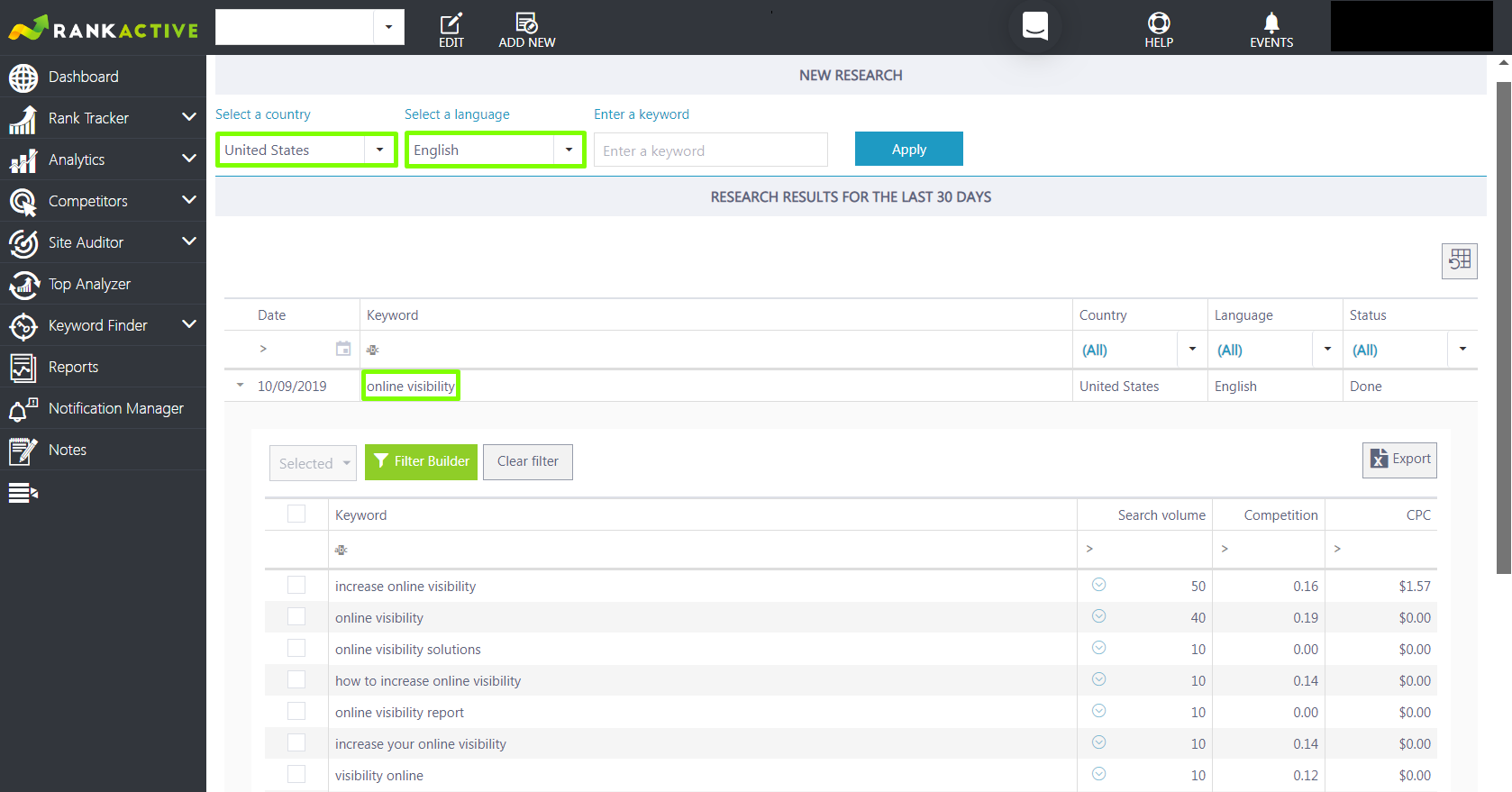How to Quickly Estimate Your Competitors’ Online Visibility with RankActive
13 September 2019 Leave a comment ALL-HANDS SEO, CONTENT MARKETING, KEYWORD RESEARCH
How does an online market look like? It’s a huge crowd of webshops, landing pages, and corporate websites. To be found in this crowd is a separate kind of art: companies start using SEO, writing blogs, gathering reviews, and so on. And how about your competitors – do they work hard in this regard? That is a hot topic for today.
At RankActive, we use two key metrics to measure online visibility: ETV (Estimated Traffic Value) and SVV (Search Visibility Value). You might have never heard about them, but we’ll fix it in a few minutes and add details on how to improve them.
What Should You Know About Online Visibility?
Let’s start with some numbers first. Have you ever thought of how many searches are conducted on Google? The Internet Live Stats platform knows it for sure – there are 40 000 queries per second! This number shows how many chances you have to be found on the web, but your competitors have them as well. The question is which of the websites searchers will find faster – that’s when online visibility appears on stage.
So, online visibility is the brand’s presence in the consumer’s web environment. In other words, it shows how easy it is to find your brand on the Internet and how often the site appears in SERPs.
What’s So Special About Online Visibility?
The higher online visibility rating you have, the more advantages you get in the long run. These are a few examples:
- Reaching out to the broadest audience ever. No matter if you have a local or international business, the vast majority of your customers surfs the web. In other words, you deal with the biggest advertising platform.
- Constantly reminding about yourself. Even if you don’t sell something to a particular person now, you can do it in the future. Online presence demonstrates that you’re here and ready to provide products and services. Next time, people may come to your website because they’ve seen your website already.
- Engaging visitors and buyers. No other platform can give you so many opportunities to speak directly to the target audience. Gathering reviews from customers or organizing a survey – there are many communication channels on the web.
- Increasing sales. The three points mentioned above lead to growing your income. People can find you easier, they give credit to your business, and, subsequently, they are ready to make a purchase.
While you’re reading this, your competitors are also fighting for growing traffic and high visibility rates. The battle is so severe that monitoring solely your rankings is not enough – you should see the broader picture to take measures when necessary.
Traffic vs. Online Visibility: Do They Mean the Same?
The short answer is no, even though they do look similar at first. The main difference is that visibility is a relative metric, while traffic is an absolute value. How often have you noticed your traffic to drop? But it doesn’t mean that your online visibility will suffer as well – it may stay the same.
Here’s a simple example. Last week, you got 550 visits from a particular keyword – this is your traffic. This week, the traffic is changing: there are 500 visits. But you still rank on the top of SERPs – it means the visibility hasn’t changed.
At the same time, if there are significant changes in online visibility, it causes changes in traffic because searchers simply won’t find your website in SERPs. Now let’s see how we compare online visibility in the competitor analysis.
The Visibility of Your Competitors: Only Two Metrics for You to Know
With RankActive, you can follow and compare your site with your competitors’ traffic, rankings, number of backlinks, and, of course, visibility.
There are only two metrics that help us see the whole perspective: ETV (Estimated traffic Value) and SVV (Search Visibility Value). These metrics are completely unique and were built solely for the visibility aspect of competitor analysis.
Estimated Traffic Value (ETV) is the total amount of traffic a website can potentially receive from all the keywords it’s ranking for in SERPs. The number of clicks, and thus traffic volume, varies depending on the website’s ranking in SERPs – the Distribution Coefficient reflects exactly that.
Search Visibility Value (SVV) is a benchmark metric that reflects on the online visibility of your website across all its keywords ranking in SERP. The more keywords you have in the top 1, the higher the percentage you get.
After adding competitors in the settings, that’s what you will see in the Visibility subsection:
This example demonstrates that having a 100% SVV is an unachievable goal. At the same time, it quickly shows who of your competitors make the best keyword research and eventually gets more top positions.
What Can You Do to Improve Your Online Visibility?
Even the smallest steps make you closer to a bigger goal. The tips we’re describing below are probably not new for you, but let’s check if you use all of them in your marketing strategy.
Tip 1: Use Relevant Keywords
How much do you know about keywords? This is the basic concept covered in every other SEO-related article, including this one. You don’t need to use keyword ideas that exactly match the user’s query as it was several years ago. That’s what we suggest doing instead:
- Make a list of important topics and issues interesting to your target audience and crucial to your business niche.
- Split the topics into subtopics to narrow down your search.
- Go to RankActive’s Keyword Finder and pick the type of keywords you want to look for. It can be keywords from Google Autocomplete, long-tail queries for voice search, ideas from Google AdWords, and more.
Depending on the keyword type, you’ll have to define different parameters: a country, a language, a location, or a search engine. For instance, you’ll find long-tail ideas in the Similar keywords subsection. Here you need to pick a country and a language:
After clicking on “Apply”, you only have to choose among dozens of keyword variations and use them on your website.
Tip 2: Create a Rocking Content
“Create high-quality content, create high-quality content” – this is a current Google mantra for each and every one of existing websites. The latest Google updates can forgive you many mistakes, but they will take away your rankings if you don’t care about your writing. So, that’s what you should start with:
- Blogging. And we don’t mean a bunch of articles filled with random keywords. Work harder on this one: share your expertise and create true value for readers, show everything you’ve got. The best advice is to follow the latest trends, make a well-thought content plan, and never stop improving the quality of your writing.
- Guest posting. Don’t have enough readers on your blog? Let them know about your company on the crowded web platform. You should write the best possible article on a given subject and promote your expertise with it. This tactic may not bring you sales right away, but it does improve your business reputation.
- Going visual. Let’s glimpse behind the curtain of the content’s future. Some experts believe that the video will eventually conquer the text, which can shift the focus of your work. So don’t limit yourself solely to high-quality images – you’ll be surprised what conversions you can get with videos and infographics.
Tip 3: Use Every Social Media Opportunity
Does social media bring more harm or good? This is an eternal topic, so let’s leave it for another conversation. In the SEO prospect, social media is a chance to market your business. Depending on the platform, there are different benefits:
- Facebook. As the most popular social media platform, it helps you stay in touch with the broadest audience.
- Twitter. Here you can grab the spotlight with only a few lines: millennials, for example, prefer short updates over longer posts.
- YouTube. We’ve just mentioned videos as the next step of content creation: there is no other platform that has such a big number of viewers.
- LinkedIn. This platform will help you improve your business reputation. You can network with business partners, follow up your competitors, and build an active profile for your current and prospective employees.
- Quora. It might be the most popular platform to ask questions and get answers. Here you can respond to your target audience, enhance the online reputation, and increase your sales. All of it is much easier with a special marketing tool like QuestionsPro.
Tip 4: Gather Customer Reviews
Reviews from other customers do wonders to your online image. For example, 91% of people between 18 and 34 years old consider online reviews as trustworthy as personal recommendations.
Online buyers can find lots of reasons not to make a purchase until they see the reviews. Is your product useful? What about the level of quality? What will I get in the end? Often, customer notes can answer all of these questions better than the website content.
To make reviews work for your benefit, start with these simple steps:
- Ask people to share their opinion: for example, offline, when they visit your place, or online on your website and various review-based platforms (Yelp, Amazon, Trustpilot, Bazaarvoice, etc.).
- Ask open-ended questions which require a detailed response: “What was the atmosphere in the restaurant?”, “How can we improve this product?”, “If you could change (something), what would it be and why?”
- Find the right moment to ask: after a successful or repeated purchase, when customers tag you in social media or mention your brand in a comment.
- Share positive reviews you already got.
- Respond to both positive and negative reviews.
Tip 5: Provide Incentives
Want people to interact more with your company? Give them a reason to do so. Depending on the niche you work in, the audience may have different values. If this is the designers’ community, they won’t mind getting a free WordPress theme. If you’re among book readers, share a few free copies of a popular bestseller.
What you can gain in the end:
- More subscribers to your newsletter.
- More mentions on social media.
- More finished purchases.
Always Stay in Plain Sight
If you notice any changes in the search visibility value, try to find a reason for that. Losing online visibility means losing traffic, which is key to your success in SERPs.
As always, several standard SEO and content marketing efforts help you stand out: conducting keyword research, creating valuable content, communicating directly with your customers, etc. All these tactics have saved lots of online reputations and will save yours.
So, are you starting with keyword research now or going straight to the Competitors section? In any case, RankActive is a great helping tool for your current goals and future marketing campaigns.
Tags: competitors, competitors analysis, content, Keyword Finder
Like this article? There’s more where that came from.
- 5 Questions to Ask Yourself Before Paying for Rank Tracking Software
- 5 Serious Mistakes Beginner SEOs Make and How to Fix Them
- Why We Use Google’s New Link Attributes and You Should Too
- Title and Description in 2021: Why Google Rewrites SEOs’ Meta Tags
- What We Should Learn From Google’s “About This Result” Feature







